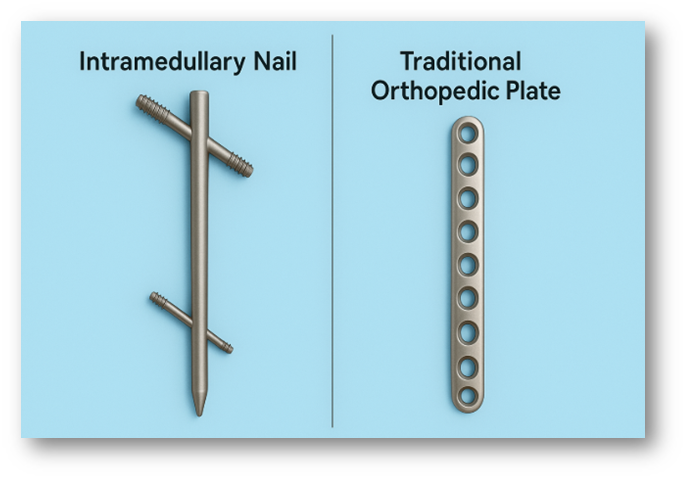
Treating long bone fractures requires an orthopedic implant that is long and sturdy
enough to provide the needed stability for proper healing. Many orthopedic surgeons
often interchangeably use intramedullary (IM) nails and
orthopedic plates for these
procedures. The choice of treatment depends on various factors, such as the severity,
location, and alignment of the fracture injury.
In this blog, we will explain both of these orthopedic products in detail in a simple manner.
What is an Intramedullary Nail?
These are rod-shaped nails inserted into the medullary canal of the fractured long bone
to provide support from within the bone. Modernly manufactured
intramedullary nails
consist of interlocking screws that prevent the nail’s rotation and maintain its length.
These nails are the gold standard for the treatment of diaphyseal and many of the
metaphyseal fractures.
-
IM nails are designed with durable titanium and stainless-steel alloys for excellent strength, resilience, and corrosion resistance.
-
These nails are created using modern and cutting-edge technology for seamless insertion and proper fit into the medullary canals of a fractured long bone.
-
Made to be available in various sizes for different bones such as femur, humerus, tibia, etc.
What is Traditional Orthopedic Plating?
Traditional orthopedic plates are fixated on the external surface of long bones with the
help of screws. They are surgically placed onto the fractured bone using the open
reduction method to provide strong fixation, which is helpful for anatomical
reconstruction.
-
Orthopedic plates are made using medical-grade titanium alloy to ensure durability, strength, and biocompatibility with internal tissues.
-
The contouring of these plates is done as per the anatomy of the long bone for proper alignment.
-
You can find these in various types, such as the
locking compression plates,
dynamic compression plates, and reconstruction plates. These products are suitable
for every fracture type.
Comparative Analysis of Both Techniques
There are several factors based on which the experts decide whether they will choose an intramedullary nailing or the plating technique for their patients. Let us discuss those in detail:
| Aspect |
IM Nails |
Traditional Plating |
| Surgical Procedure |
Minimally invasive with small incisions |
Open reduction with large incisions |
| Biomechanical Stability |
Internal support; high load-bearing capacity |
External support; strong load distribution |
| Fracture Suitability |
Shaft and some metaphyseal fractures |
Periarticular and complex fractures |
| Complication Rates |
Lower infection risk; chance of misalignment |
Higher infection risk; better alignment |
| Healing & Weight-Bearing |
Faster recovery; early weight-bearing |
Longer recovery; delayed mobility |
| Impact on Soft Tissue |
Preserves blood supply; minimal tissue damage |
Potential soft tissue disruption |
Clinical Outcomes and Considerations
Below are some clinical findings that demonstrate the importance of choosing the right treatment method and product based on the patient’s condition and fracture type. An experienced orthopedic surgeon always considers this evidence to ensure the best possible result for their patients.
Union Rates
During a randomized clinical trial, experts chose to execute both of these treatment
methods for treating closed and noncomminuted tibial fractures with intact fibulae.
It was found that both the IM nails and plates showed higher union rates by providing
the needed support for bone healing.
Risk of Infection
Surgery done using intramedullary nails was associated with a lower risk of infection when compared to the traditional plating method, which reaches up to 34%. It is because of the minimally invasive approach of IM nails that they cause less soft tissue disruption, which preserves the blood supply, thereby preventing infection.
Malunion & Non-union
Since done externally, plating enables surgeons to ensure precise anatomical alignment
of the fracture, which lowers the risk of malunion, particularly in periarticular
fractures. While IM nails protect the inner blood supply, which lowers the risk of
non-union of fractured bone, especially in midshaft fractures. A few studies also
report that there is an increase in malunion rate with IM nails, but the non-union
rate always remains low using both of these techniques and products.
How to Decide the Right Orthopedic Implant Out of These Two for the Long Bone Fractures?
It is important for surgeons to choose the right method out of IM nailing and
traditional plating for the treatment of long bone fractures. Making the right
decision has a lot of impact on a patient’s well-being and life style.
Hence,make sure to remember the following.
-
Location & Pattern of the Fracture: Given their functions and features, the IM nails are ideal to use for midshaft fractures of the long bones. The traditional orthopedic plates are mostly indicated for periarticular and complex fractures.
-
Patient Attributes: An elderly patient who has weaker bones requires sturdy and rigid fixation using traditional plates. On the other hand, a younger and active patient can benefit from early mobilization ensured by the IM nails.
-
Surgeon Experience & Expertise: Both of these methods require expertise and skills. Hence, this factor solely depends on what suits the surgical team’s experience.
-
Product Availability: IM nails are more affordable and minimally invasive, whereas orthopedic plates involve huge resources and are placed through the open reduction method.
Make the Choice with Our Experts: Your Partner in Decision
Both the IM nails and traditional plating have their own set of advantages and disadvantages when it comes to their usage. However, there are many factors that need to be considered before you make a final decision. At Sharma Orthopedic, our experts promise to support the surgeons by providing a comprehensive portfolio of orthopedic products that will make your every attempt a successful outcome. Being your partner in this journey, we are here to help you make the last and best choice.